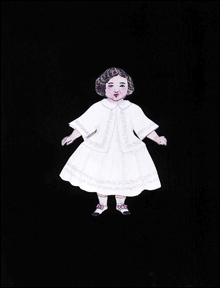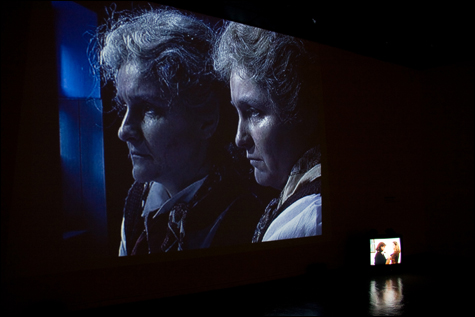
IMAGE FROM A DREAM: Stacy Renee
Morrison’s paper doll.
|
If the University of Rhode Island’s exhibit “Close Encounters: Central European Video Art” is any indication, artists from that region are feeling forlorn. But the predominance of this mood may just be a coincidence in the sampler of nine videos by five artists here, plus an additional artist and video at the Kingston train station.
Guest curator Viera Levitt, a native Slovak who has lived in Rhode Island for two years, avoids the usual scenes of dreary apartment blocks and industrial sites of Europe’s former communist countries. Instead, she writes in the exhibit brochure, she chooses videos “that concentrate on human stories, of vulnerability and fragility, emotions I believe that we all share.”
Hungary-born, Berlin-based Hajnal Nemeth’s NataSsa (2000) shows a woman in black striding across an empty green field, walking into trees, and arriving at a tall cross standing on a pedestal, which seems to be a grave marker. She leaps backward into the air and lands on the pedestal, straddling the cross, like a crucified specter. It’s probably just a trick of reversing the footage, but it feels uncanny.
In Czech artist Milena Dopitova’s 2003 video Green Plateaus I, two older women alternately dance together in the puddles of a paved park or sit side by side playing a piano. They move a bit gingerly, as if leaning on each other for support, but the women look so alike that they could be the same woman. (They are in fact the artist and her 40-year-old twin sister made up to look old.) It prompts thoughts of isolation, dependence, and loneliness in old age.
Czech artist Katerina Seda’s It Doesn’t Matter (2005-07) shows an elderly woman drawing a light fixture. The video is mundane, but an accompanying book explains that the woman is the artist’s grandmother who mostly stopped cooking, cleaning, shopping, or going out for walks after she retired. Instead she stays in bed late and watches TV. “I was up to things my whole life,” she says in the book. “Now I’m resting.” The artist finds her grandmother’s idleness disconcerting, and tries to draw her out by having her draw items sold at a home supplies store where she formerly worked. Is there any more dreadful way to be drawn back into the world?

ISOLATION AND LONELINESS: Milena Dopitova’s Green Plateaus I.
|
The university’s Fine Arts Center Galleries also offer Slovak artist Pavel Pecha’s 13 “Staged Photographs.” Scenes, all set on a mowed field, include a woman laying under a shroud like a corpse; shrouded figures walking against the wind; people rising from holes in dirt, all facing a cellist on a tall platform; and two seated men facing each other while a shrouded table hangs from poles in the air between them. They feel like glimpses of some arch experimental theater.
The university’s photography gallery presents “Girl of My Dreams” by New Yorker Stacy Renee Morrison, and organized by galleries director Judith Tolnick Champa. Several years ago, Morrison came into possession of an old trunk containing paper dolls, daguerreotypes, a ribbon, a dance card from an 1860 ball in Boston in honor of the Prince of Wales. At first Morrison dreamed princess dreams of the life of Sylvia DeWolf Ostrander, the 19th-century woman who seems to have put together the trunk. When Morrison investigated who the woman really was, she found that Ostrander had been part of the Bristol aristocracy.
All this inspired Morrrison’s photos of a doll floating in what might be a river, a white ribbon curling against a velvety black void, a paper doll with three paper dresses, and a framed daguerreotype of two severe-looking girls, apparently Ostrander and a sister. They have an air of 19th-century romance crossed with contemporary perfume ads. The proceedings get into eerie territory (think Alfred Hitchcock’s Vertigo) when Morrison photographically merges her face with Ostrander’s, and in another photo apparently dons her clothing and walks into the ocean. Morrison doesn’t connect the dots between the objects or make a strong case for why these objects or Ostrander herself demand our attention, but individual images are attractive.
“Close Encounters: Central European Video Art” | Through February 10 | Stacey Renee Morrison, “Girl Of My Dreams” | Through March 16 | Pavel Pecha, “Staged Photographs” | Through February 28 | University of Rhode Island, 105 Upper College Road, Kingston | 401.874.2775 |
On the Web
Univeristy of Rhode Island: uri.edu/artgalleries